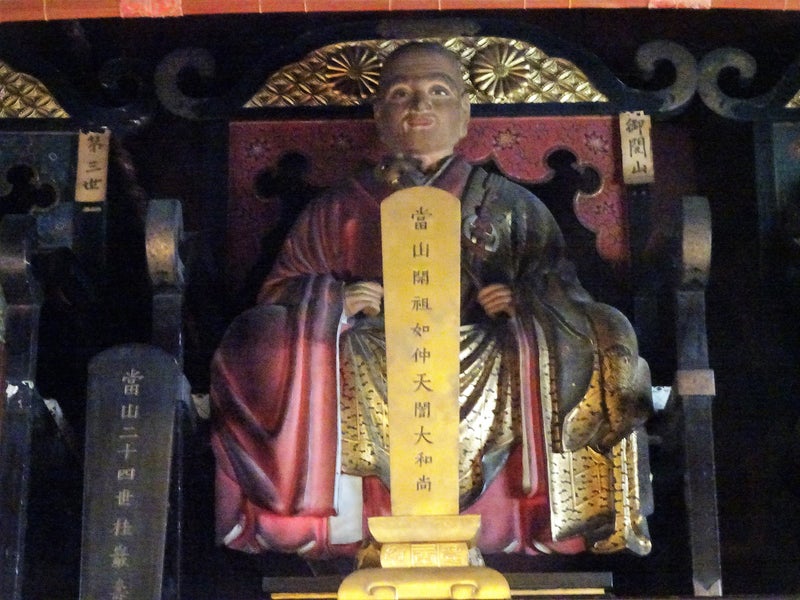ZEN MESTEREK ZEN MASTERS
« Zen főoldal
« vissza a Terebess Online nyitólapjára

如仲 [恕仲] 天誾 Jochū Tengin (1365-1437)
Jochû Tengin (1365-1437)
http://www.treeleaf.org/articles/TreeleafTheLineage.html
A native of the province of Shinano (in the current prefecture of Nagano), his family surname was Mino. Tengin studied with the Rinzai Master Daisetsu Sonô, from whom he accepted ordination, then later with Baisan Mompon from whom he received transmission. Thereafter, Tengin went on to the province of Omi (in the current prefecture of Shiga) where he built a hermitage of the name Tôshun'in, that he soon renamed Tôju'an. A lord of the province of Tôtômi (in the current prefecture of Shizuoka) named Yamauchi then requested him to build a temple at which the lord could make prayers. In 1401, Tengin gave up all his other activities and went in search of a favorable location. He found the place guided, according to legend, by the Bodhisattva Kannon. There, he built a temple that he later named 大洞院 Daitô'in, inaugurated in 1411. Tengin made his own Master, Baisan Mompon, the honorary founder of the temple, with Tengin himself becoming officially the second abbot. The shogun Ashikaga Yoshimochi offered neighboring lands in donation.
Once the monastery was completed, legend goes, the kami of the mountain came during the night into the apartments of Tengin in order to receive from him the Zen precepts. These were granted, and in thanks the kami promised Tengin to create a mineral spring not far from there. The next morning, there occurred a light earthquake and water spouted out of the mountainside, flowing even today …
In 1430, Tengin took over as the Abbot of Ryûka'in in the province of Echizen (in the current prefecture of Fukui), where Tengin remained three years before returning to Tôju'in. He died in the 12th year of the Eikyô era (1440) at the age of 75 years. Before dying, Tengin required of his disciples that his funeral would remain simple and that, in the place of ceremonies, they would all assemble to sit in meditation. Of the 17,549 current temples of the Sôtô school, more than 3.200 trace their line to Jochû Tengin.
Zen Ancestors Chart:
佛祖正傳菩薩大戒血脈
Busso shōden bosatsu daikai kechimyaku
The Bloodline of the Buddha’s and Ancestors’ Transmission of the Great Bodhisattva Precepts
1. Eihei Dōgen
(永平 道元 1200-1253)
2. Koun Ejō
(孤雲 懐奘 1198-1280)
3. Tettsū Gikai
(徹通 義介 1219-1309)
4. Keizan Jōkin
(螢山 紹瑾 1268-1325)
5. Gasan Jōseki
(峨山 韶碩 1275-1366)
6. Taigen Sōshin
(太源 宗真 ?-1371)
7. Baizan Monpon
(梅山 聞本 ?-1417)
8. Jochū Tengin
(恕仲 天誾 1365-1437)
9. Sekisō Enchū
(石叟 圓柱 ?-1455)
![]()
Jochû Tengin (1365-1437)
http://www.zen-occidental.net/nishijima/lignee.html
Il était de la province de Shinano (dans l'actuelle préfecture de Nagano) et son nom de famille était Mino. Il étudia avec le maître Rinzai Daisetsu Sonô dont il reçut l'ordination puis avec Baisan Mompon dont il reçut la transmission. Par la suite, il se rendit dans la province d'Omi (dans l'actuelle préfecture de Shiga) où il construisit un ermitage du nom de Tôshun'an qu'il rebaptisa immédiatement en Tôju'in. Un seigneur de la province de Tôtômi (dans l'actuelle préfecture de Shizuoka) du nom de Yamauchi le pria ensuite de faire construire un temple dans lequel il pourrait prier. En 1401, Tengin abandonna toutes ses activités et se mit en quête d'un terrain propice. Il trouva le lieu guidé, selon la légende, par le bodhisattva Kannon. Il fit construire un temple qu'il baptisa Teikyô'in puis rapidement 大洞院 Daitô'in qui fut inauguré en 1411. Il fit de son maître, Baisan Mompon, le fondateur honoraire du temple, lui-même devenant officiellement le second abbé. Le shogun Ashikaga Yoshimochi offrit les terres alentours. Une fois le monastère construit, le kami de la montagne vint nuitamment dans les appartements de Tengin afin de recevoir les préceptes zen. Ce dernier l'ordonna et pour le remercier le kami lui promit de créer une source d'eau minérale, non loin de là. Le lendemain matin, il y eut un léger tremblement de terre et la source jaillit du flanc de la montagne. La source coule toujours... En 1430, Tengin prit la charge du Ryûka'in dans la province d'Echizen (dans l'actuelle préfecture de Fukui) fondé par son maître où il séjourna trois ans, puis il revint au Tôju'in. Il mourut le 5-11 de la 12e année de l'ère Eikyô (1440) à l'âge de 75 ans. Avant de mourir, Tengin demanda à ses disciples que ses funérailles restent simples et, qu'à la place des cérémonies, ils s'assoient tous en méditation.
Sur les 17.549 temples actuels de l'école sôtô, plus de 3.200 font remonter leur lignée à Jochû Tengin.
![]()
Jochū Tengin
(如仲 [恕仲] 天誾 1365-1437)
如仲天誾 じょちゅう - てんぎん
1365-1437 南北朝 - 室町時代の僧。
貞治 (じょうじ )4= 正平 ( しょうへい)20 年 9 月 5 日生まれ。曹洞 (そうとう) 宗。梅山聞本 (ばいさん - もんぽん) に師事し , その法をつぐ。遠江 (とおとうみ) (静岡県) に崇信寺, 大洞院を開創し, のち能登 (のと) (石川県) 総持寺にのぼる。永享 2 年越前 (えちぜん) (福井県) 竜沢寺の住持となり, 同寺を復興した。永享 9 年 2 月 4 日死去。 73 歳。信濃 (しなの) (長野県) 出身。俗姓は海野。
『 大洞院 略縁起
応永 18 年(1411 年)恕仲天誾 (じょちゅうてんぎん) 禅師は観音菩薩の教示により、初めてこの地に錫を留めますと、時の将軍足利義持公は禅師の高徳を慕い帰依して、自らその荘園とその境内の地とを寄贈し、禅師の為に一大梵刹を創建し、これを橘谷山大洞院と号した。以来数百年大洞院の門風ますます栄え、今や大本山総持寺の御直末で全国に末寺 3400 余ヶ寺の総本山であり、曹洞宗屈指の名刹であります。 』
https://09270927.at.webry.info/201406/article_4.html